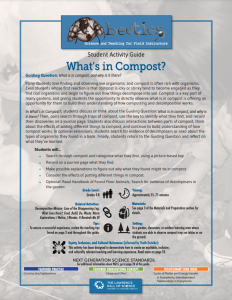Guiding Question: What is in compost, and why is it there?
Many students love finding and observing live organisms, and compost is often rich with organisms. Even students whose first reaction is that compost is icky or stinky tend to become engaged as they find cool organisms and begin to figure out how things decompose into soil. Compost is a key part of many gardens, and giving students the opportunity to directly observe what is in compost is offering an opportunity for them to build their understanding of how composting and decomposition works.
In What’s in Compost?, students discuss or think about the Guiding Question: What is in compost, and why is it there? Then, pairs search through trays of compost, use the key to identify what they find, and record their discoveries on a journal page. Students also discuss interactions between parts of compost, think about the effects of adding different things to compost, and continue to build understanding of how compost works. In optional extensions, students search for evidence of decomposers or read about the types of organisms they found in a book. Finally, students return to the Guiding Question and reflect on what they’ve learned.
Students will…
• Search through compost and categorize what they find, using a picture-based key.
• Record on a journal page what they find.
• Make possible explanations to figure out why what they found might be in compost.
• Consider the effects of putting different things in compost.
• Optional: Read Handbook of Forest Floor Animals; Search for evidence of decomposers in the garden
Special Acknowledgements
We want to acknowledge Justice Outside for reviewing this session and supporting us to develop more equitable, inclusive, and culturally relevant instructional materials. Read more about our collaboration with Justice Outside.

